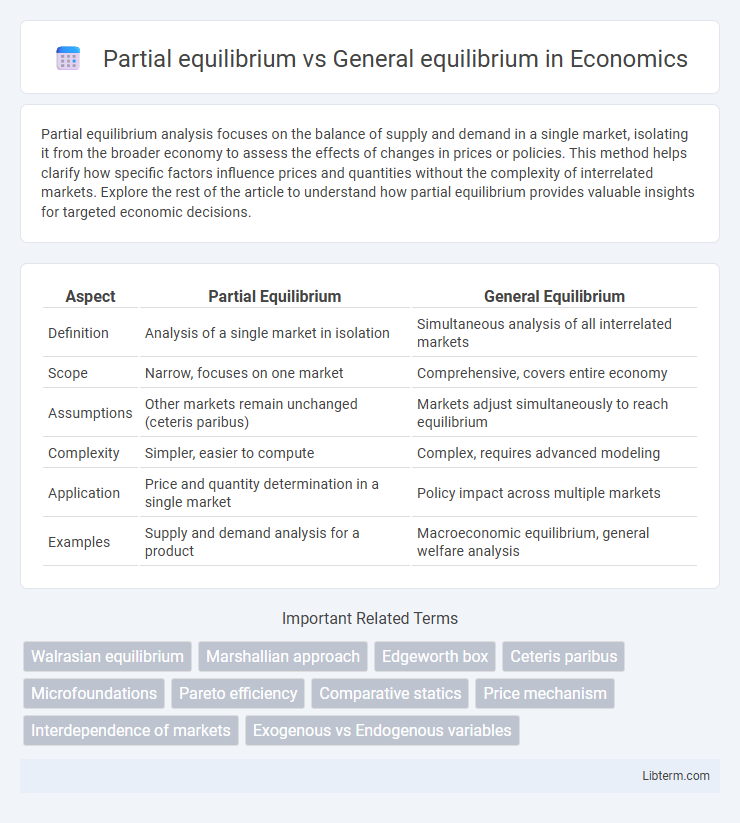Partial equilibrium analysis focuses on the balance of supply and demand in a single market, isolating it from the broader economy to assess the effects of changes in prices or policies. This method helps clarify how specific factors influence prices and quantities without the complexity of interrelated markets. Explore the rest of the article to understand how partial equilibrium provides valuable insights for targeted economic decisions.
Table of Comparison
| Aspect | Partial Equilibrium | General Equilibrium |
|---|---|---|
| Definition | Analysis of a single market in isolation | Simultaneous analysis of all interrelated markets |
| Scope | Narrow, focuses on one market | Comprehensive, covers entire economy |
| Assumptions | Other markets remain unchanged (ceteris paribus) | Markets adjust simultaneously to reach equilibrium |
| Complexity | Simpler, easier to compute | Complex, requires advanced modeling |
| Application | Price and quantity determination in a single market | Policy impact across multiple markets |
| Examples | Supply and demand analysis for a product | Macroeconomic equilibrium, general welfare analysis |
Introduction to Economic Equilibrium
Economic equilibrium occurs when supply and demand balance in a market, determining prices and quantities. Partial equilibrium analyzes this balance in a single market independently, assuming other markets remain unchanged. General equilibrium examines interconnected markets simultaneously, capturing the broader economy-wide interactions affecting equilibrium outcomes.
Defining Partial Equilibrium
Partial equilibrium analysis examines the equilibrium condition in a single market or sector, ignoring interactions with other markets. It evaluates how changes in supply and demand within that specific market impact prices and quantities, holding external factors constant. This approach is essential for understanding localized economic effects without the complexity of entire economic interdependencies.
Explaining General Equilibrium
General equilibrium analyzes the simultaneous interaction of multiple markets, capturing how supply and demand balance across an entire economy. It incorporates interdependencies between sectors, consumers, and factors of production, providing a comprehensive framework for understanding resource allocation. This approach contrasts with partial equilibrium, which examines individual markets in isolation without accounting for broader economic linkages.
Key Differences Between Partial and General Equilibrium
Partial equilibrium analyzes a single market or sector assuming other markets remain unchanged, focusing on supply and demand within that isolated system. General equilibrium examines all markets simultaneously, capturing the interdependencies and feedback effects across the entire economy. The key difference lies in scope: partial equilibrium simplifies by holding external factors constant, while general equilibrium models the comprehensive interactions between multiple markets and agents.
Assumptions Underlying Partial Equilibrium Analysis
Partial equilibrium analysis assumes ceteris paribus, isolating a single market while holding other markets constant, ignoring feedback effects from other sectors. It presumes perfect competition, with prices adjusting solely within the targeted market to restore equilibrium. This approach simplifies analysis but limits its ability to capture interdependencies present in general equilibrium models.
Assumptions Underlying General Equilibrium Analysis
General equilibrium analysis assumes perfect competition, complete markets, and that all agents have perfect information and rational preferences, ensuring that all markets simultaneously clear. It also presumes no externalities or public goods, allowing prices to fully reflect all costs and benefits within the economy. These assumptions contrast with partial equilibrium, which analyzes a single market in isolation, ignoring interactions among multiple markets.
Advantages and Limitations of Partial Equilibrium
Partial equilibrium analysis offers a focused examination of a single market, making it simpler and less data-intensive than general equilibrium models. It allows for clear insights into price and quantity adjustments within one market without the complexity of inter-market interactions. However, its limitation lies in ignoring feedback effects and cross-market externalities, which can lead to incomplete or misleading conclusions in an interconnected economy.
Advantages and Limitations of General Equilibrium
General equilibrium analysis offers the advantage of capturing the interdependence between multiple markets simultaneously, providing a comprehensive view of economic outcomes and resource allocation efficiency across an entire economy. It overcomes the limitations of partial equilibrium by incorporating feedback effects and interactions among sectors, enabling better policy evaluation and welfare analysis. However, general equilibrium models often face challenges such as high complexity, reliance on strong assumptions for market completeness and perfect competition, and significant computational demands, which may limit their practical applicability and empirical validation.
Applications in Real-World Economic Analysis
Partial equilibrium analysis is commonly applied in sector-specific studies like analyzing the impact of tax changes or subsidies on a particular market, such as the agricultural or energy sector, providing detailed insights into supply and demand shifts within isolated markets. General equilibrium models are essential for assessing comprehensive policy impacts affecting multiple interconnected markets simultaneously, such as trade agreements or macroeconomic policy changes, capturing the feedback effects across the entire economy. Real-world economic analysis leverages partial equilibrium for targeted interventions and general equilibrium for evaluating systemic economic interactions and policy outcomes.
Choosing the Right Equilibrium Model
Choosing between partial equilibrium and general equilibrium models depends on the scope and complexity of the economic analysis. Partial equilibrium models focus on a single market or sector, isolating variables to assess specific price and quantity adjustments without considering feedback effects from other markets. In contrast, general equilibrium models encompass multiple interrelated markets simultaneously, capturing comprehensive interactions and providing a holistic view of economic equilibrium under changes in policy, technology, or preferences.
Partial equilibrium Infographic

 libterm.com
libterm.com